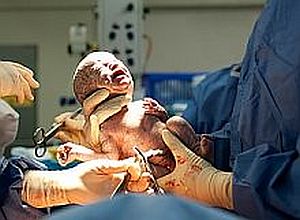Women who deliver their first child by caesarean section (C-section) are less likely to conceive a second child than those who deliver vaginally, despite being just as likely to plan a subsequent pregnancy, according to Penn State College of Medicine researchers. The team followed more than 2,000 women for three years after they delivered their first child.
Kristen Kjerulff, professor of public health sciences, said that although previous studies showed that women who delivered by C-section were less likely to bear subsequent children, it was unclear to researchers whether this was due to maternal choice or a lower rate of conception.
The researchers followed women from before the birth of their first child and interviewed them every six months until three years after their first delivery. During each interview, they asked women to report how often they had unprotected intercourse in each of the previous six months.
Kjerulff and colleagues analysed data from 2,021 women between the ages of 18 and 35 who provided data on unprotected intercourse and resulting conceptions for three years after their first birth. Nearly 600 of those women delivered their first child by C-section and those women were more likely to be older, overweight and obese, shorter, and more likely to have sought fertility advice, testing or treatment.
Approximately 69% of women who delivered by C-section conceived after unprotected intercourse compared to approximately 78% of women who delivered vaginally. Women who delivered by C-section also had a reduced likelihood of a live birth. The association remained after researchers accounted for maternal age, pre-pregnancy body mass index, time to conception of the first child, gestational weight gain, prior induced abortions, diabetes, hypertension, hospitalization during pregnancy and other factors.
Dr Richard Legro, a co-author of the manuscript and chair of the department of obstetrics and gynaecology at Penn State Health Milton S Hershey Medical Centre, says that controlling for intercourse was a key strength of the study and allowed the researchers to rule out trauma or lingering pain from C-section. Although the study didn't investigate the reasons for the decreased conception rate, he suspects there may be some physiological reasons.
"It's possible that pelvic or (fallopian) tubal scarring as a result of being exposed to open air and contaminants may affect subsequent attempts at getting pregnant," Legro said. "It is also possible that scar formation from the surgical wound in the uterus, though not in an area where pregnancies implant, may have lingering effects on the process of implantation."
Based on the findings from this study, Kjerulff and Legro recommend that women under 35 who fail to conceive after a year of unprotected intercourse following a C-section seek medical help. Legro noted the data from this study may be useful for physicians counseling women who elect to have C-sections.
"It's important that women who elect to have a C-section know that there is a chance they may have difficulty conceiving in the future," Legro said.
Abstract
Importance: More than 20% of births globally are by cesarean delivery, including more than 30% in the US. Prior studies have reported lower rates of childbearing after cesarean delivery, but it is not clear if this is due to maternal choice or lower conception rates.
Objective: To investigate the association between mode of first delivery and subsequent conceptions and live births.
Design, Setting, and Participants: The First Baby Study was a multicenter prospective cohort study of women aged 18 to 35 years with singleton pregnancies, enrolled and interviewed before first childbirth, who delivered in Pennsylvania from 2009 to 2011 and were followed up for 36 months after delivery (until April 2014). Data analysis for this study took place between May and July 2019 and in January 2020.
Exposures: Mode of first delivery (cesarean or vaginal).
Main Outcomes and Measures: Rates of subsequent conceptions and live births. Discrete-time Cox proportional hazard regression models were used to compare the rate of subsequent conception (vaginal vs cesarean) among those who completed the 36-month survey, accounting for reported months of unprotected intercourse during the follow-up period and adjusting for relevant covariates. A log binomial regression was used to compare the age-adjusted rate of subsequent live birth (vaginal vs cesarean) among those who completed the 36-month survey.
Results: The study population consisted of 2423 women who were retained to the 36-month survey (mean [SD] age at baseline was 27.2 [4.4] years and 712 [29.4%] delivered by cesarean). There were 2046 women who had unprotected intercourse during the follow-up period, 2021 of whom provided data on months of unprotected intercourse. Cesarean delivery was associated with lower rates of conception after unprotected intercourse during the follow-up period (413 of 599 [68.9%]) compared with vaginal delivery (1090 of 1422 [76.7%]) (adjusted hazard ratio, 0.85; 95% CI, 0.74-0.96). Cesarean delivery was also associated with reduced likelihood of a subsequent live birth (305 women [42.8%]) compared with vaginal delivery (857 women [50.1%]), with an age-adjusted risk ratio of 0.83 (95% CI, 0.75-0.92).
Conclusions and Relevance: In the 3 years following first childbirth, women who delivered their first child by cesarean had lower rates of conception after unprotected intercourse, and fewer of these women had a second child than those who delivered vaginally.
Authors
Kristen H Kjerulff, Ian M Paul, Carol S Weisman, Marianne M Hillemeier, Ming Wang, Richard S Legro, John T Repke
[link url="https://news.psu.edu/story/625239/2020/07/09/research/women-who-deliver-c-section-are-less-likely-conceive-subsequent"]Penn State material[/link]
[link url="https://jamanetwork.com/journals/jamanetworkopen/fullarticle/2764595?resultClick=3"]JAMA Open Network abstract[/link]

